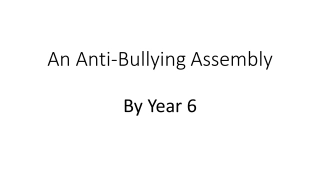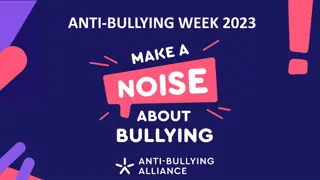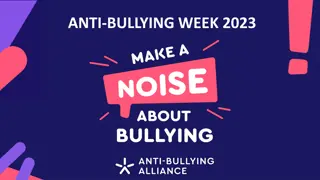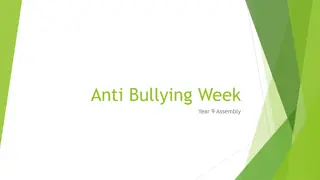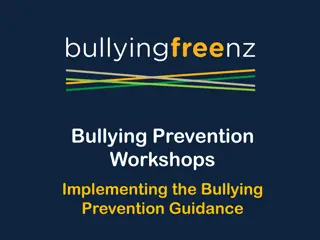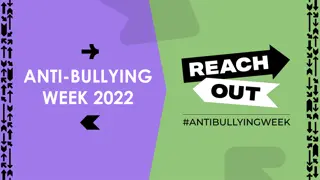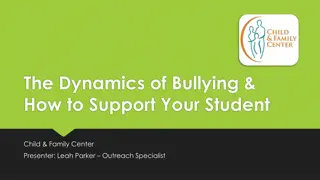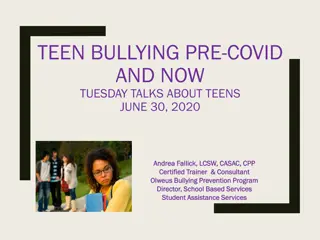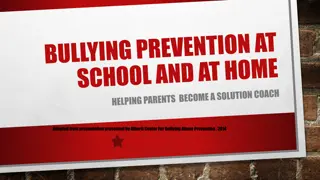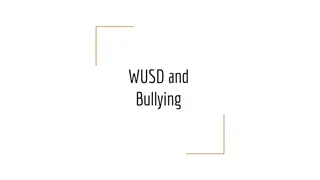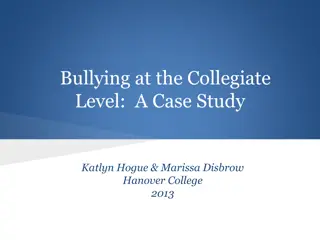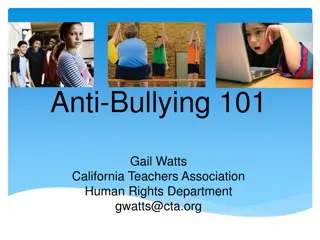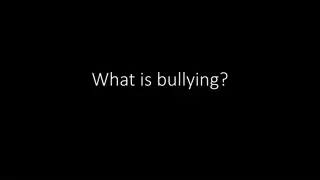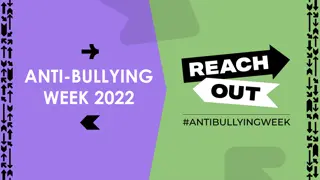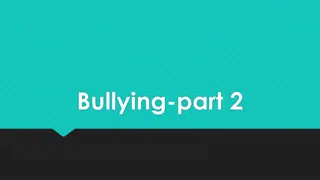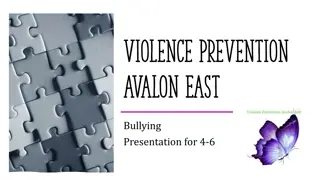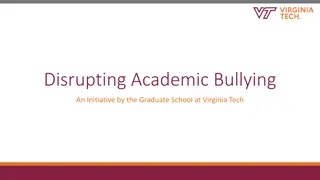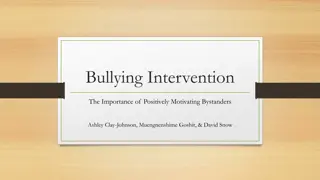Understanding and Preventing Bullying in Various Settings
Bullying can take different forms such as verbal, physical, or cyberbullying, leading to long-term negative impacts on victims. It is crucial to have strong anti-bullying measures in place, as outlined by RBWO standards, to create safe and nurturing environments free from harassment and intimidation. Early intervention is key in preventing the escalation of bullying behaviors that can persist into adulthood. By recognizing the signs and implementing effective prevention strategies, we can combat this harmful behavior and promote healthier relationships and well-being.
- Bullying prevention
- Anti-bullying strategies
- Cyberbullying awareness
- Emotional impact
- Early intervention
Download Presentation

Please find below an Image/Link to download the presentation.
The content on the website is provided AS IS for your information and personal use only. It may not be sold, licensed, or shared on other websites without obtaining consent from the author. Download presentation by click this link. If you encounter any issues during the download, it is possible that the publisher has removed the file from their server.
E N D
Presentation Transcript
BULLYING AWARENESS AND PREVENTION Recruitment and Training Supervisor Eleasa Smith
CHILDKIND POLICY REGARDING BULLYING Childkind provides an environment for all children in care, employees, foster parents, and volunteers that is free from harassment, intimidation, or bullying. Childkind supports a nurturing and rewarding experience. This type of environment promotes personal growth, healthy interpersonal relationships, wellness, and freedom from discrimination and abuse. Therefore, harassment, intimidation, and bullying are forms of dangerous and disrespectful behavior that will not be tolerated by Childkind.
RBWO STANDARDS DEFINES BULLYING AS Deliberately hurtful behavior, usually repeated over a period of time, where it is difficult for those bullied to defend themselves. It can take many forms, but the three main types are physical (e.g. hitting, kicking, theft), verbal (e.g. racist or homophobic remarks, threats, name calling) and emotional (e.g. isolating an individual from the activities and social acceptance of their peer group). The damage inflicted by bullying can frequently be underestimated. It can cause considerable distress to children, to the extent that it affects their health and development or, at the extreme, causes them significant harm (including self- harm). All settings in which children are provided with services or are living away from home should have in place rigorously enforced anti-bullying strategies.
Bullying can be verbal, physical, or via the Internet. It can severely affect the victim's self-image, social interactions, and school performance often leading to insecurity, lack of self-esteem, and depression in adulthood. School dropout rates and absences among victims of bullying are much higher than among other students. Studies have shown that children who have been identified as a bully by age eight are six times more likely to have a criminal conviction by age 24. Children who are bullies may continue to be bullies as adults, and are more prone to becoming child and spouse abusers. http://www.nctsn.org/resources/public-awareness/bullying-prevention-awareness-month
The behavior is never appropriate and is intentional. This repeated and hurtful act includes: name calling, inflicting physical pain, exclusion, public humiliation, hurtful pranks and defacing one's property. Bullying involves an imbalance of power. The innocent one being bullied feels alone, depressed and scared and feels they have nowhere to turn. Bullying includes: Calling someone hurtful and derogatory names Spreading lies and bad rumors about someone Being mean and teasing someone Hitting, punching, shoving, spitting and physically hurting someone Social exclusion or isolation ... not including someone is a group Getting certain kids or teens to "gang up" on others Having money or other things taken or damaged Being threatened or being forced to do things
Bullying is a problem that affects millions of students of all races and classes. 1 out of 4 kids is bullied and depending on their ages up to 43% of students have been bullied while online. Child and teen Bullying and Cyberbullying are at an all-time high. Some kids are so tormented that suicide has become an alternative for them. It has everyone worried. Not just the kids on its receiving end, but the parents, teachers and others who may not understand how extreme bullying can get. Love Our Children USA is working aggressively to prevent these issues and to help the kids and teens affected by it.
Bullying can also happen on-line or electronically. Cyberbullying is when kids or teens bully each other using the Internet, mobile phones or other cyber technology. This can include: Sending mean text, e-mail, or instant messages Posting nasty pictures or messages about others in blogs or on Web sites Using someone else's user name to spread rumors or lies about someone Stealing someone's password and spreading rumors about someone else making it seem like that person is the Cyberbully https://www.youtube.com/watch?v=znqRnCSwNN0 https://www.youtube.com/watch?v=znqRnCSwNN0
BULLYING STATISTICS 1 out of 4 teens are Bullied. A poll of teens ages 12-17 proved that they think violence increased at their schools. 9 out of 10 LGBTQ students experienced harassment at school and online. 282,000 students are physically attacked in secondary schools each month. 5.4 million Students stay home on any given day because they're afraid of being bullied. More youth violence occurs on school grounds as opposed to on the way to school. 1 out of 5 kids admits to being a bully, or doing some "Bullying." 80% of the time, an argument with a bully will end up in a physical fight. 43% fear harassment in the bathroom at school. 1/3 of students surveyed said they heard another student threaten to kill someone. Playground statistics - Every 7 minutes a child is bullied. Adult intervention -4% Peer intervention - 11%. No intervention - 85%. 2 out of 3 say they know how to make a bomb, or know where to get the information to do it. Children with disabilities were two to three times more likely to be bullied than their nondisabled peers.
CYBERBULLYING As the use of technology itself has evolved, so has the ability to bully. Bullying, once restricted to the school or neighborhood, has now moved into the online world. Bullying through electronic means is referred to as cyberbullying.
Definitions of Cyber Bullying include: Cyberbullying is defined as willful and repeated harm inflicted through the use of computers, cell phones, and other electronic devices (Hinduja & Patchin, 2015 Cyberbullying occurs when someone repeatedly makes fun of another person online or repeatedly picks on another person through e-mail or text message or when someone posts something online about another person that they don t like (Cyberbullying Research Center, 2016). Cyberbullying is intentional and repeated harm inflicted on others through the use of electronic devices (Cyberbullying Research Center, 2016). Cyberbullying is as an aggressive, intentional act distributed by an individual or group, using contact in an electronic medium, continuously and relentlessly against someone who cannot stand up for himself or herself easily (Smith et al., 2008).
CYBERBULLYING STATISTICS Depending on the age group, up to 43% of students have been bullied while online. 1 in 4 have had it happen more than once. 35% of kids have been threatened online. Nearly 1 in 5 have had it happen more than once. 21% of kids have received mean or threatening e-mail or other messages. 58% of kids admit someone has said mean or hurtful things to them online. More than 4 out of 10 say it has happened more than once. 53% of kids admit having said something mean or hurtful to another person online. More than 1 in 3 have done it more than once. 58% have not told their parents or an adult about something mean or hurtful that happened to them online.
Steps to take should you find that your child has been bullied Find out pertinent and detailed information about what the bullies are doing, dates, times, places, actions, etc. Document everything. You should never approach the person that is the aggressor. Find out any threats that have been made toward your child, and if it pertains to outside of school; contact the police. Contact the school during hours of operation and make an appointment with the principal for a face to face meeting. Obtain a copy of the school s anti-bullying policy to determine if the bully violated a school policy. Ask what you can do together to stop the bullying. Follow up with your child to see if the bullying stops, and follow up with the principal. If the bullying continues, document it, you may need to move up the chain of command, contacting the superintendent of schools, board of education, or possibly even authorities. If your child has been cyberbullied, check the school s anti-bullying policy as well as contact law enforcement If the bullying does not stop you should file charges with the school board and law enforcement if appropriate.
Some feel that bullying is a normal rite of passage in growing up. It isnt!! Although There will always be conflicts between kids, bullying, intentional cruelty, harassment are not acceptable. Childkind has a no Harassment or bullying policy. Should you feel that any of the children placed in your home has is being subjected to any of the behaviors listed above please notify the school, Childkind, DFCS immediately.
Resources for Parents https://www.stopbullying.gov https://www.cybersmile.org www.stompoutbullying.org/bullying-tips/parentresources211online.unitedwayatlanta.org
Sources http://www.cdc.gov/ViolencePrevention/youthviolence/index.html http://www.bullyingstatistics.org/content/cyber-bullying-statistics.html http://www.Olweus.org http://www.stopbullyingnow.hrsa.gov/ http://youthviolence.edschool.virginia.edu/violence-in-schools/national-statistics.html Disabilities: Insights from Across Fields and Around the World; Marshall, Kendall, Banks & Gover (Eds.), 2009) Childkind Policy 2018 Section https://www.youtube.com/watch?v=znqRnCSwNN0 Stop Bullying https://www.stopbullying.gov/ Ditch the Label https://us.ditchthelabel.org/top-10 Very Well Family https://www.verywellfamily.com/ways


